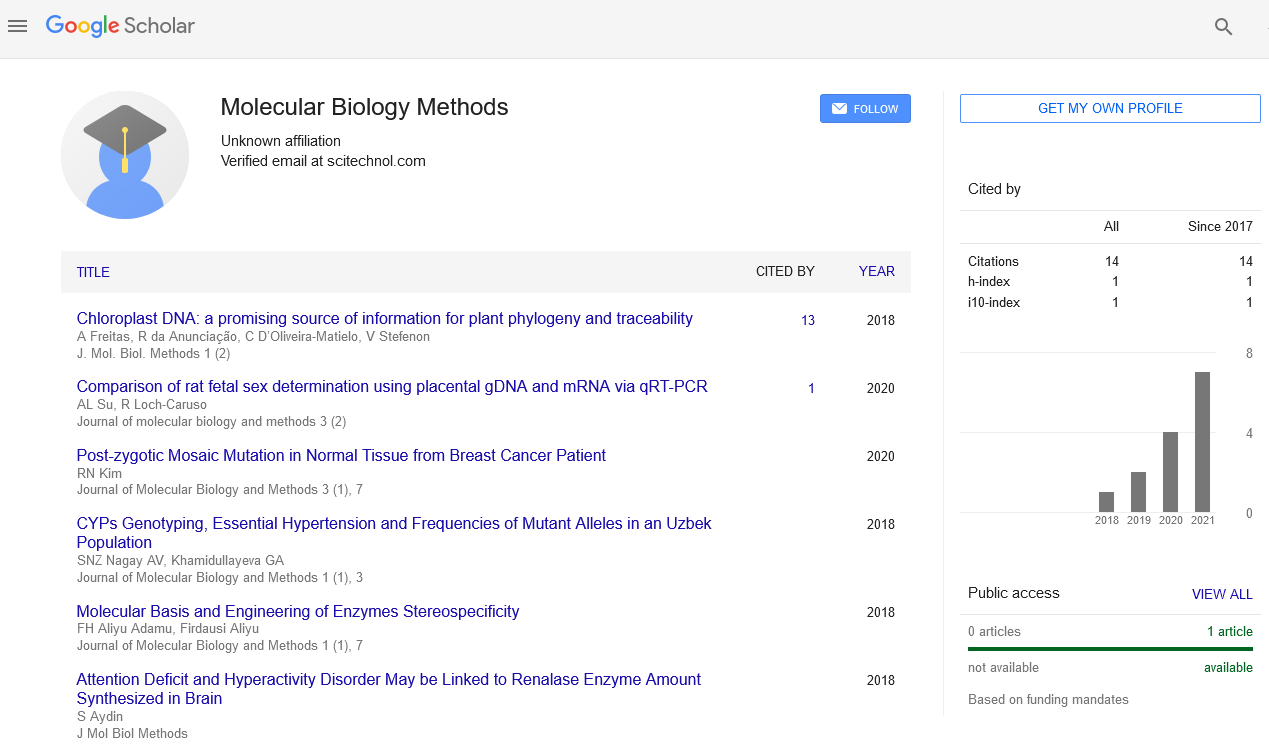Perspective, J Mol Biol Methods Vol: 7 Issue: 3
Polymerase Chain Reaction: A Revolutionary Tool in Molecular Biology
Melinda Susan*
1Department of Stem Cell and Regenerative Biology, Harvard University, Cambridge, United States of America
*Corresponding Author: Melinda Susan,
Department of Stem Cell and Regenerative
Biology, Harvard University, Cambridge, United States of America
E-mail: susan09394@harvard.edu
Received date: 26 August, 2024, Manuscript No. JMBM-24-151577;
Editor assigned date: 28 August, 2024, PreQC No. JMBM-24-151577 (PQ);
Reviewed date: 11 September, 2024, QC No. JMBM-24-151577;
Revised date: 18 September, 2024, Manuscript No. JMBM-24-151577 (R);
Published date: 25 September, 2024 DOI: 10.4172/JMBM.1000174
Citation: Susan M (2024) Polymerase Chain Reaction: A Revolutionary Tool in Molecular Biology. J Mol Biol Methods 7:3.
Description
The Polymerase Chain Reaction (PCR) is one of the most influential techniques in molecular biology. PCR allows for the amplification of specific DNA sequences, making it possible to generate millions of copies of a targeted DNA segment from a small initial sample. This process had great implications across various fields, including genetics, forensics, medicine and evolutionary biology. At its core, PCR is a simple yet powerful enzymatic process that influences the natural ability of DNA polymerases to synthesize new strands of DNA. The reaction requires a few key components: The DNA template, primers, nucleotides and a heat-stable DNA polymerase. The process involves a series of temperature cycles that facilitate the denaturation, annealing and extension of DNA strands.
The first step in PCR is denaturation, where the double-stranded DNA template is heated to around 94°C-98°C. This high temperature causes the hydrogen bonds between the complementary base pairs to break, resulting in two single strands of DNA. Following denaturation, the temperature is lowered to approximately 50°C-65°C during the annealing phase. Here, short DNA primers designed to match sequences flanking the target DNA region bind to the single-stranded DNA templates. The specificity of these primers is important, as they determine which segment of DNA will be amplified.
Once the primers are successfully annealed to the template strands, the reaction temperature is raised to around 72°C for the extension step. This is the optimal temperature for Taq polymerase, a heat-stable enzyme derived from the thermophilic bacterium Thermus aquaticus. Taq polymerase adds nucleotides to the 3' ends of the primers, synthesizing new complementary strands of DNA. As this cycle of denaturation, annealing, and extension is repeated typically 20 to 40 times the amount of target DNA increases exponentially. After 30 cycles, millions of copies of the target sequence can be obtained from a single initial template.
One of the key advantages of PCR is its sensitivity. The ability to amplify DNA from minute quantities makes it invaluable in a variety of applications. In clinical diagnostics, for instance, PCR is used to detect the presence of pathogens in patient samples, such as viruses and bacteria. This capability has proven important in the early detection of infectious diseases, including HIV and COVID-19, where rapid diagnosis can significantly impact treatment outcomes and public health responses.
PCR also plays a vital role in forensic science. It enables the analysis of trace DNA evidence from crime scenes, allowing for the identification of suspects or victims even when the sample size is extremely small. The technique's ability to produce sufficient DNA for profiling has transformed criminal investigations, providing law enforcement with a powerful tool for solving cases that might otherwise go cold.
In conclusion, the polymerase chain reaction has fundamentally transformed the landscape of molecular biology and its applications. From clinical diagnostics and forensic analysis to genetic research and evolutionary studies, PCR has enabled scientists to explore the intricacies of life at a molecular level with unprecedented ease and accuracy. As technology continues to advance, the development of new variants of PCR and related techniques promises to enhance its capabilities further, ensuring that it remains a cornerstone of modern scientific research. The impact of PCR is great, reflecting its status as one of the most significant innovations in the history of biology.
 Spanish
Spanish  Chinese
Chinese  Russian
Russian  German
German  French
French  Japanese
Japanese  Portuguese
Portuguese  Hindi
Hindi 